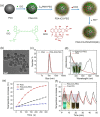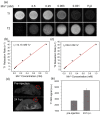Polydopamine Nanoparticles as a Versatile Molecular Loading Platform to Enable Imaging-guided Cancer Combination Therapy
- PMID: 27217836
- PMCID: PMC4876627
- DOI: 10.7150/thno.14431
Polydopamine Nanoparticles as a Versatile Molecular Loading Platform to Enable Imaging-guided Cancer Combination Therapy
Abstract
Cancer combination therapy to treat tumors with different therapeutic approaches can efficiently improve treatment efficacy and reduce side effects. Herein, we develop a theranostic nano-platform based on polydopamine (PDA) nanoparticles, which then are exploited as a versatile carrier to allow simultaneous loading of indocyanine green (ICG), doxorubicin (DOX) and manganese ions (PDA-ICG-PEG/DOX(Mn)), to enable imaging-guided chemo & photothermal cancer therapy. In this system, ICG acts as a photothermal agent, which shows red-shifted near-infrared (NIR) absorbance and enhanced photostability compared with free ICG. DOX, a model chemotherapy drug, is then loaded onto the surface of PDA-ICG-PEG with high efficiency. With Mn(2+) ions intrinsically chelated, PDA-ICG-PEG/DOX(Mn) is able to offer contrast under T1-weighted magnetic resonance (MR) imaging. In a mouse tumor model, the MR imaging-guided combined chemo- & photothermal therapy achieves a remarkable synergistic therapeutic effect compared with the respective single treatment modality. This work demonstrates that PDA nanoparticles could serve as a versatile molecular loading platform for MR imaging guided combined chemo- & photothermal therapy with minimal side effects, showing great potential for cancer theranostics.
Keywords: Combination therapy; Indocyanine green; Magnetic resonance imaging.; Nano-Drug delivery system; Polydopamine.
Conflict of interest statement
Competing Interests: The authors have declared that no competing interest exists.
Figures





Similar articles
-
Chemotherapeutic drug-photothermal agent co-self-assembling nanoparticles for near-infrared fluorescence and photoacoustic dual-modal imaging-guided chemo-photothermal synergistic therapy.J Control Release. 2017 Jul 28;258:95-107. doi: 10.1016/j.jconrel.2017.05.011. Epub 2017 May 10. J Control Release. 2017. PMID: 28501673
-
Indocyanine green-loaded polydopamine-iron ions coordination nanoparticles for photoacoustic/magnetic resonance dual-modal imaging-guided cancer photothermal therapy.Nanoscale. 2016 Oct 21;8(39):17150-17158. doi: 10.1039/c6nr05502h. Epub 2016 Aug 19. Nanoscale. 2016. PMID: 27539790
-
Doxorubicin and Indocyanine Green Loaded Hybrid Bicelles for Fluorescence Imaging Guided Synergetic Chemo/Photothermal Therapy.Bioconjug Chem. 2017 Sep 20;28(9):2410-2419. doi: 10.1021/acs.bioconjchem.7b00407. Epub 2017 Aug 24. Bioconjug Chem. 2017. PMID: 28810733
-
Application of polydopamine in tumor targeted drug delivery system and its drug release behavior.J Control Release. 2018 Nov 28;290:56-74. doi: 10.1016/j.jconrel.2018.10.009. Epub 2018 Oct 9. J Control Release. 2018. PMID: 30312718 Review.
-
Functionalized theranostic nanocarriers with bio-inspired polydopamine for tumor imaging and chemo-photothermal therapy.J Control Release. 2019 Sep 10;309:203-219. doi: 10.1016/j.jconrel.2019.07.036. Epub 2019 Jul 27. J Control Release. 2019. PMID: 31362077 Review.
Cited by
-
Injectable, Antioxidative, and Tissue-Adhesive Nanocomposite Hydrogel as a Potential Treatment for Inner Retina Injuries.Adv Sci (Weinh). 2024 Mar;11(11):e2308635. doi: 10.1002/advs.202308635. Epub 2024 Jan 17. Adv Sci (Weinh). 2024. PMID: 38233151 Free PMC article.
-
Degradation Products of Polydopamine Restrained Inflammatory Response of LPS-Stimulated Macrophages Through Mediation TLR-4-MYD88 Dependent Signaling Pathways by Antioxidant.Inflammation. 2019 Apr;42(2):658-671. doi: 10.1007/s10753-018-0923-3. Inflammation. 2019. PMID: 30484006
-
Surface Engineering of Metal-Organic Framework as pH-/NIR-Responsive Nanocarrier for Imaging-Guided Chemo-Photothermal Therapy.Int J Nanomedicine. 2020 May 7;15:3235-3250. doi: 10.2147/IJN.S239910. eCollection 2020. Int J Nanomedicine. 2020. PMID: 32440121 Free PMC article.
-
NIR light-assisted phototherapies for bone-related diseases and bone tissue regeneration: A systematic review.Theranostics. 2020 Sep 26;10(25):11837-11861. doi: 10.7150/thno.49784. eCollection 2020. Theranostics. 2020. PMID: 33052249 Free PMC article.
-
T1-Positive Mn2+-Doped Multi-Stimuli Responsive poly(L-DOPA) Nanoparticles for Photothermal and Photodynamic Combination Cancer Therapy.Biomedicines. 2020 Oct 14;8(10):417. doi: 10.3390/biomedicines8100417. Biomedicines. 2020. PMID: 33066425 Free PMC article.
References
-
- Coates A, Abraham S, Kaye SB, Sowerbutts T, Frewin C, Fox RM. et al. On the receiving end—patient perception of the side-effects of cancer chemotherapy. Eur J Cancer and Clin Onco. 1983;19:203–8. - PubMed
-
- Min KH, Park K, Kim Y-S, Bae SM, Lee S, Jo HG. et al. Hydrophobically modified glycol chitosan nanoparticles-encapsulated camptothecin enhance the drug stability and tumor targeting in cancer therapy. J Control Release. 2008;127:208–18. - PubMed
-
- Sonvico F, Mornet S, Vasseur S, Dubernet C, Jaillard D, Degrouard J. et al. Folate-Conjugated Iron Oxide Nanoparticles for Solid Tumor Targeting as Potential Specific Magnetic Hyperthermia Mediators: Synthesis, Physicochemical Characterization, and in Vitro Experiments. Bioconjugate Chem. 2005;16:1181–8. - PubMed
-
- Liu J, Wang C, Wang X, Wang X, Cheng L, Li Y. et al. Mesoporous Silica Coated Single-Walled Carbon Nanotubes as a Multifunctional Light-Responsive Platform for Cancer Combination Therapy. Adv Funct Mater. 2015;25:384–92.
Publication types
MeSH terms
Substances
LinkOut - more resources
Full Text Sources
Other Literature Sources
Medical
Miscellaneous

